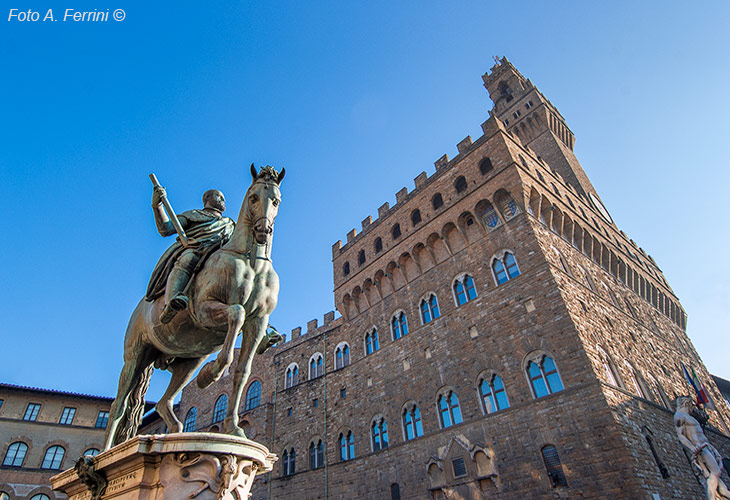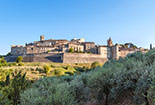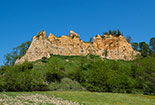THE TERRITORY AROUND THE CASENTINO
in Casentino, a Tuscan valley with which you can get familiar in every detail through this site

Texts and photos by Alessandro Ferrini ©
70 accurately described images that illustrate the territory around the Casentino. Click to enlarge
Countries, cities and territories around the Casentino
 Casentino is a land that offers countless aspects of cultural, naturalistic and landscape interest. Its villages are almost all of medieval origin and have generally taken the place of important castles that belonged to the powerful Guidi family, in the highest part of the valley, and to the Arezzo bishopric, in the middle and lower Casentino. The medieval castles are one of the most fascinating aspects of this land, we should mention the Castle of Poppi, that of Romena and Porciano. Equally fascinating are the large Romanesque churches built around the middle of the 12th century: that of Romena, of Stia, of Montemignaio, of Strada, of Socana. Valuable art is present in this valley, mostly preserved inside the churches. Works ranging from the last decades of the thirteenth century to the eighteenth century. We can see these aspects as precious stones set in a typical Tuscan landscape, in a land that smells like bread and where green is the dominant color. All this is in turn enclosed between the Tuscan-Romagna Apennine ridge, where the Casentinesi Forests, Monte Falterona and Campigna National Park are located, and the Pratomagno massif. Mountainous areas with superb nature and capable of offering great views. Within the National Park there are two important places of faith whose notoriety goes
Casentino is a land that offers countless aspects of cultural, naturalistic and landscape interest. Its villages are almost all of medieval origin and have generally taken the place of important castles that belonged to the powerful Guidi family, in the highest part of the valley, and to the Arezzo bishopric, in the middle and lower Casentino. The medieval castles are one of the most fascinating aspects of this land, we should mention the Castle of Poppi, that of Romena and Porciano. Equally fascinating are the large Romanesque churches built around the middle of the 12th century: that of Romena, of Stia, of Montemignaio, of Strada, of Socana. Valuable art is present in this valley, mostly preserved inside the churches. Works ranging from the last decades of the thirteenth century to the eighteenth century. We can see these aspects as precious stones set in a typical Tuscan landscape, in a land that smells like bread and where green is the dominant color. All this is in turn enclosed between the Tuscan-Romagna Apennine ridge, where the Casentinesi Forests, Monte Falterona and Campigna National Park are located, and the Pratomagno massif. Mountainous areas with superb nature and capable of offering great views. Within the National Park there are two important places of faith whose notoriety goes  far beyond local borders: Camaldoli and La Verna. Places immersed in nature that have two great figures as a reference: San Romualdo and San Francesco.
far beyond local borders: Camaldoli and La Verna. Places immersed in nature that have two great figures as a reference: San Romualdo and San Francesco.
The Casentino, therefore, offers us a lot. This land can also be considered the basis for going to visit other interesting territories, towns and cities around it.
Florence is on average an hour's drive from this valley. Since the Middle Ages, the capital of the Italian Renaissance had had commercial relations with the Casentino, mainly with two products, the wool and the timber of its forests. On the Florentine part of the Pratomagno massif is Vallombrosa, a large abbey in the forest founded by the monk Giovanni Gualberto around 1050.
The eastern side of the Apennines and a strip of land on its slopes is called Tuscan Romagna. This name derives from the fact that until 1923 this area was part of Tuscany. From that date it passed under Romagna mainly for one reason: Mussolini wanted the Tiber, the river of the capital, to have its source in Romagna, its region of origin. In this area we find centers such as Galeata, Santa Sofia, Bagno di Romagna with its thermal waters known since Roman times. This area can be reached quickly from the Casentino through the streets of Passo dei Mandrioli and Passo della Calla. With a detour from this last road it is possible to visit the Ridracoli Dam, a beautiful reservoir in the mountains of the National Park.
From Bagno di Romagna in about fifty kilometers (the first twenty on the E45 highway towards Cesena) it is possible to reach San Leo di Romagna. A timeless place defined by Umberto Eco as "the most beautiful city in Italy". A village essentially composed of two very ancient churches whose architecture is something extraordinary, a beautiful square and an impregnable fortress known for being the prison of Cagliostro. A place located on a rocky spur at six hundred meters above sea level that also fascinated San Francesco and Dante Alighieri. From Bagno di Romagna it is possible to return to Casentino through another interesting route. Still taking the E45, this time towards Rome, we head towards Valtiberina, the first land bathed by the Tiber. Leaving at Verghereto, after a few kilometers we can reach the nearby source of this historic river. Continuing on, we will reach Pieve Santo Stefano, a pleasant village home to the interesting Diary Museum. From the town, through the Passo dello Spino road, we go up to Monte della Verna. From this Franciscan place in about twenty kilometers we reach the Casentino valley floor.
From Bagno di Romagna it is possible to return to Casentino through another interesting route. Still taking the E45, this time towards Rome, we head towards Valtiberina, the first land bathed by the Tiber. Leaving at Verghereto, after a few kilometers we can reach the nearby source of this historic river. Continuing on, we will reach Pieve Santo Stefano, a pleasant village home to the interesting Diary Museum. From the town, through the Passo dello Spino road, we go up to Monte della Verna. From this Franciscan place in about twenty kilometers we reach the Casentino valley floor.
From Pieve Santo Stefano continuing on the E45, or the parallel provincial road, we pass by the beautiful Montedoglio Dam, the largest lake in Tuscany. We then reach Sansepolcro, an elegant village of medieval origins, the birthplace of Piero della Francesca. In the Civic Museum there is the Resurrection, one of the masterpieces of this Renaissance artist. From Sansepolcro seven kilometers of completely straight road lead us to Anghiari, the architectural jewel of Valtiberina. The place developed from the 12th century around a Camaldolese monastery. It also became known for the important Battle of Anghiari in 1440 between the Florentine and Milanese troops which decreed the supremacy of the Tuscan city in this territory.
Nine kilometers from Anghiari is Monterchi, a town that originated from a castle that until 1440 belonged to the Tarlati di Pietramala. The testimonies of this fortified place are still visible. Particular notoriety to the village is given by the "Madonna del Parto", a beautiful fresco by Piero Della Francesca.
A couple of kilometers from Monterchi is Citerna, in the Umbrian land. A place that deserves a visit for its architecture and what remains of the fortress.
From Anghiari we can head towards Arezzo using the  Via della Libbia which takes us through Chiassa Superiore where there is a beautiful Romanesque church, or return towards the Casentino passing through Caprese Michelangelo, the birthplace of the great sculptor, painter, and architect of the sixteenth century where it is possible visit an interesting museum divided into three buildings.
Via della Libbia which takes us through Chiassa Superiore where there is a beautiful Romanesque church, or return towards the Casentino passing through Caprese Michelangelo, the birthplace of the great sculptor, painter, and architect of the sixteenth century where it is possible visit an interesting museum divided into three buildings.
Arezzo is the provincial capital to which the Casentino territory belongs, one of the four valleys located on this part of Tuscany. The city has Etruscan origins, then experienced the Roman civilization. Apart from a large amphitheater that takes us back to this second historical period, the architectural and artistic testimonies that Arezzo shows us today are essentially medieval and Renaissance.
To the south of the city is the Valdichiana crossed by two main roads. The one on the left introduces us to Castiglion Fiorentino, the Castle of Montecchio and Cortona, a town located on a hill also of Etruscan origin. For its architecture, its museums, palaces and churches it has international fame. We are now on the border with Umbria which begins with Lake Trasimeno.
From Cortona a road that crosses beautiful agricultural contexts leads us towards Foiano della Chiana. Lugo this street is worth visiting the extraordinary Abbey of Farneta.
From the beautiful village of Foiano, also known for its carnival, we can return to Arezzo using the other important road in the Valdichiana. Along this route we will meet other interesting and historical villages among which Monte San Savino and Lucignano stand out. From this area of the Valdichiana it is possible to reach Siena in about half an hour by car. The Valdarno is divided from the Casentino by the Pratomagno massif. From Arezzo we can enter this territory with two important routes. The Regional Road 69 which will take us to beautiful and historic towns along the Arno such as Montevarchi, Terranuova Bracciolini and San Giovanni Valdarno, the birthplace of Masaccio. The other way is the Strada Setteponti which partly follows the Cassia Vetus, a Roman road that connected Arezzo with Fiesole. We will use this second route which starts from the Romanesque Ponte Buriano. It winds its way through the western slopes of Pratomagno and passes through or near characteristic villages such as Rondine, Castiglion Fibocchi, Laterina, Il Borro, San Giustino Valdarno, Loro Ciuffenna, Castelfranco di Sopra, Reggello. This road also introduces us to fascinating Romanesque churches, that of San Pietro a Gropina, Santa Maria a Scò, San Pietro a Cascia di Reggello. From this town, a pleasant road through the greenery climbs to the Vallombrosa Abbey that we mentioned at the beginning of this itinerary. From this sacred place, through the road of Passo della Consuma, or the one that passes through Montemignaio, you can return to Casentino.
The Valdarno is divided from the Casentino by the Pratomagno massif. From Arezzo we can enter this territory with two important routes. The Regional Road 69 which will take us to beautiful and historic towns along the Arno such as Montevarchi, Terranuova Bracciolini and San Giovanni Valdarno, the birthplace of Masaccio. The other way is the Strada Setteponti which partly follows the Cassia Vetus, a Roman road that connected Arezzo with Fiesole. We will use this second route which starts from the Romanesque Ponte Buriano. It winds its way through the western slopes of Pratomagno and passes through or near characteristic villages such as Rondine, Castiglion Fibocchi, Laterina, Il Borro, San Giustino Valdarno, Loro Ciuffenna, Castelfranco di Sopra, Reggello. This road also introduces us to fascinating Romanesque churches, that of San Pietro a Gropina, Santa Maria a Scò, San Pietro a Cascia di Reggello. From this town, a pleasant road through the greenery climbs to the Vallombrosa Abbey that we mentioned at the beginning of this itinerary. From this sacred place, through the road of Passo della Consuma, or the one that passes through Montemignaio, you can return to Casentino.
















































































